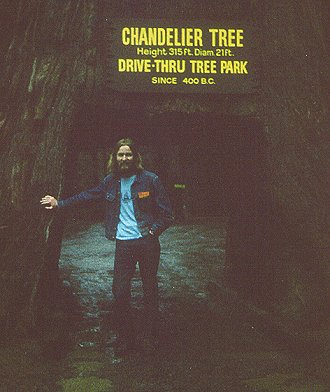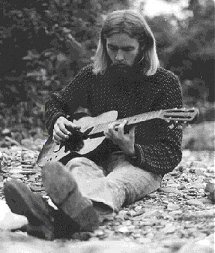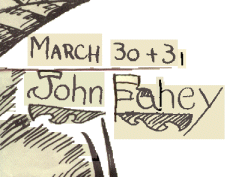|
Anyway, when I appeared at the consert with my buddy with a house on his car, Nick Rogers (where are you now, Nick?) they were sold out, but luckily me coming all the way from the land of Polar bears made enough impression, so they let us in after all.
And mr. Fahey was living right up to the myth: Came in, sat down, played for half an hour, took a glass of water, played for another half hour, bowed and went, to enormous applause from the dedicated audience! Afterwards, still being a VIP from Norway, I was allowed into the artist's wardrobe, this in a way became sort of an anticlimax; Essentially a shy person, I was a little embarrassed, the artist was, as we have seen, not a man of many words, and there were several other people there in oriental dress. Evidently, I thought to myself, they had some kind of religious thing together.
(Contents)
Home Again
 But for me this was enough, my mission was fullfilled, I could travel back to my country, but to contribute a little to the Kottke mythology as well, in a record shop on Cannery Row I got hold of his first record for 1 dollar, less than a thousand copies issued! ("12-String Blues/Live at the Scholar" Oblivion, 1969, according to Kottkes notes on "Mudlark" it "sometimes turns white and crumbles around the edges"). Unfortunately, I never got to hear it, and a couple of days later, I forgot the plastic bag with the clenody in the back of a pickup truck. But for me this was enough, my mission was fullfilled, I could travel back to my country, but to contribute a little to the Kottke mythology as well, in a record shop on Cannery Row I got hold of his first record for 1 dollar, less than a thousand copies issued! ("12-String Blues/Live at the Scholar" Oblivion, 1969, according to Kottkes notes on "Mudlark" it "sometimes turns white and crumbles around the edges"). Unfortunately, I never got to hear it, and a couple of days later, I forgot the plastic bag with the clenody in the back of a pickup truck.
Back on the road. Roberta Flack had a major hit: "Killing me Softly" that was constantly on the radio. Some of the trip back was in a drive-away car from San Francisco to Florida. You paid for the gas only (cheap). I started up and drove for nearly 48 hours in a row just with coffee-breaks. I do not recommended this! A lot of people I met on my way had good advice for me, in particular against hitch-hiking in Georgia. Sheriffs were lurking along the road, and if they didn't have other criminality to attend to, they would bring in hitch-hikers and give them a free haircut! But I was among the lucky ones to avoid this humiliating experience, and very soon I was on the plane back to the polar bears.
At a pawnbroker in San Diego I had bought an old Martin 1-18 for $250. "Way too much", they told me at GTR (now Gruhn Guitars) in Nashville later on (at some point it had been refinished). But I don't know. Being a poor student, I sold it later on to afford another Martin, but I found myself regretting it almost immediately, and I pestered the various owners for many years before I succeeded in bying it back. I still have it, it is stowed away, the case still stuffed for transportation purposes with Nashville papers of the time. Whenever I am in a nostalgic mood, I take it out, (it is feather feather light and quite fragile) and play it for a while, before it is stowed away again, like "The sleeping beauty" of the old legend.
(Contents)
The Inevitabe Road to Lutherie
As the years went I had many guitars, all needing repairs and alterations, which I performed very energetically. New fingerboards, bridges, backs and tops. I even stripped, sanded and sprayed an entire guitar with nitrocellulose lacquer in my single-room living quarters. That's a thing you do only once! The snag about buying parts and materials for guitars is that the more you buy, the cheaper it gets. This, of course, is part of a cunning plan thought out by the vendors of such ware to make you a life-long addict. If you are a bit economical, like me, very soon you'll discover that you have a lot of stuff lying around! Then you really are on the hook! It would be stupid to try to get rid of the stockpile, which nobody wants to buy anyway exept maybe for a fraction of its value. Furthermore, knots and cracks seem to materialise in stock that used to be flawless, making it unmarketable (and of course you have also bought some tools, made jigs, etc). Sooner or later, and more or less inevitably, you have completed your first guitar!
(Contents)
The Quest for Success!
While building #1 you include many mistakes, and you feel so miserable about the result that you start one more immediately, doing less (and some new) mistakes. Kind friends and relatives take care of these first attempts, so you'd better have lots of both. After about 10 guitars you feel more comfortable about your products, and all your friends have one guitar. It is time to start looking beyond the nearest circle!
My first guitar saw the light of day in 1981. It is an "Irving Sloane-dreadnaught" (Sloane passed away in 1998, he wrote some of the first books about guitarbuilding, he was an eminent designer, and a real jack-of-all-trades). I checked up on this guitar last summer, it has been hanging on a wall in a farmhouse, and remarkably enough it did not even need an adjustment, a fact that I interpret like this: Irving Sloane (and I) build sturdy enough guitars!
(Contents)
The Secret Revealed
Since then there has been around 20 instruments from my hand, and libraries of lutherie books have been written, but the true recipe of success as a luthier was not revealed to me before I read Robert Benedettos book "Making an Arch--top Guitar". This is not a direct citation, it is what I get out of it, and I bring it along here for all you budding guitarmakers to consider: Get up at 05.00 AM, get down in the workshop, and with small pauses you work until well into the evening. Et voila! Work, work and work again. (And, please let an expert take care of the marketing). In other words: With lots of elbow grease, long days and some talent, maybe 10%, you're bound to succeed. Good luck!
(Contents)
LUTHIER Audun Hofseth
Fjellveien 27, N-4838 Arendal, NORWAY
Tel. +47 90842337
E-mail: [email protected]
Copyright Audun Hofseth, 1999 - www.hofseth.biz
|

 I repeat: If you do not enjoy reminizing, you'd probably be better off linking back to the
I repeat: If you do not enjoy reminizing, you'd probably be better off linking back to the  To save some money, I joined the working masses, freezing bitterly at a small shipyard during the cold winter. And Heureka! Against all odds, I got a visa very promptly and efficiently, and in march 1973 I was headed for New York! There it turned out to be winter, too, which came as a bit of a shock to me, who was planning to travel by the thumb, with a tent and a very thin sleeping-bag. NY was no place to spend a lot of time, so I took the bus to Paterson, New Jersey and from there as fast as I could to L.A.!
To save some money, I joined the working masses, freezing bitterly at a small shipyard during the cold winter. And Heureka! Against all odds, I got a visa very promptly and efficiently, and in march 1973 I was headed for New York! There it turned out to be winter, too, which came as a bit of a shock to me, who was planning to travel by the thumb, with a tent and a very thin sleeping-bag. NY was no place to spend a lot of time, so I took the bus to Paterson, New Jersey and from there as fast as I could to L.A.! So I hereby serve you my contribution to the Fahey mythology! I doubt many people could have been allowed into that closet. Anyway, in the back of McCabe's there were regular conserts, and it turned out that Fahey was appearing there in the end of the month! The pictures are from the flyer with the program of the month, look what they wrote:
So I hereby serve you my contribution to the Fahey mythology! I doubt many people could have been allowed into that closet. Anyway, in the back of McCabe's there were regular conserts, and it turned out that Fahey was appearing there in the end of the month! The pictures are from the flyer with the program of the month, look what they wrote: But for me this was enough, my mission was fullfilled, I could travel back to my country, but to contribute a little to the Kottke mythology as well, in a record shop on
But for me this was enough, my mission was fullfilled, I could travel back to my country, but to contribute a little to the Kottke mythology as well, in a record shop on